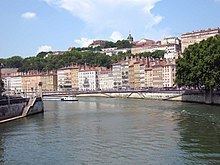 | ||
Hotels Hotel de la Croix Rousse, Appartement Les P'tits Canuts, La Poste Hotel, Cocon Prune, Le Soulary Restaurants L'Origo, Saveurs de PY, Mr Edgar restaurant, L'Oenoth de Lyon, Color Vegan Similar Fourvière, Vieux Lyon, Place Bellecour, Parc de la Tête d'Or, Presqu'île | ||
This zone is served by the metro line C
Map of La Croix-Rousse, 69004 Lyon, France
La Croix-Rousse is a hill (254m) in the city of Lyon, France, as well as the name of a neighborhood located on this hill. The neighborhood is divided into les pentes (slopes, belonging to the city's 1st arrondissement) and le plateau (atop the hill, part of the 4th arrondissement). The name "La Croix-Rousse" (The red cross) comes from a reddish-brown stone cross erected there in the 16th century.
The appearance of the neighborhood is heavily influenced by the central role that Lyon played in silk industry. The vast majority of buildings in the area feature large vaulted ceilings with exposed wooden rafters. The larger internal height available in these buildings, compared to other areas in Lyon, was necessary to house the tall silk looms that were operated in the area. Of note, also, are the traboules of Croix-Rousse. These are covered passageways used by silk merchants to travel and ferry material between buildings while being sheltered from rain. It has since been subject to gentrification, and now exhibits a vibrant cultural scene. La Croix-Rousse has always possessed a unique atmosphere compared to the rest of the city. As an illustration, some inhabitants call themselves "Croix-roussiens" (Croix-Roussians).
In Lyon, La Croix-Rousse is nicknamed la colline qui travaille (the hill that works) in contrast to the better-known hill to the southwest, Fourvière, which is known as la colline qui prie (the hill that prays). The district started developing in the 18th century when the silk workshops moved here from the Vieux Lyon area. The canuts (silk workers) were subject to extremely poor working conditions. On account of these conditions, they staged many worker uprisings, known as the Canut revolts. The first revolt, in October 1831 is considered to be one of the very first worker uprisings. The area was immortalised in Paul-Jacques Bonzon's book series Les Six Compagnons, which depicts the adventures of seven young working class teenagers from the area.
